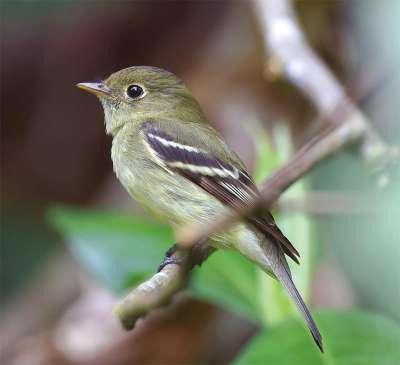For more than a quarter-century, the dawn and the trees have hardly changed at Bear Swamp. Each June for the past 27 years, which is nearly half my life, I’ve bushwhacked the same route into these woods here in north-central Vermont, through the lovely muck, past steadfast tamaracks, and beneath the familiar croaks of common ravens. Bear Swamp is one of the most enduring things in my life. Except that now the yellow-bellied flycatchers are gone.
They had called a liquid “tseh-lek” to me at Station No. 5 on my annual trek through Bear Swamp, which is not actually a swamp but rather wet coniferous woods. At each of five points (flagged trees) on my route, I stop for exactly 10 minutes to count every bird I hear or see. My annual tally, along with those from other birders, constitutes one of the most ambitious forest bird population studies on the continent.
Station No. 5 has always been my favorite. On my way there I step over tiny pink eruptions of twinflower, Linnaea borealis, the most elegant plant in these woods, the one named for Carl Linnaeus and the North. On damp mornings, which is most mornings at Bear Swamp, the lung lichen glows green on tree trunks like nothing else in the forest. And all the while, yellow-bellied flycatchers normally beckon me onward.
Now they beckon no more. This isn’t particularly newsworthy.
Forests are nothing if not about growth and change and death. And whether we let them go wild, manage them, or do something in between, forests also have business of their own, subject to events near and far and beyond our control. No better examples of that than forest birds.
Except for the black-capped chickadees, hairy woodpeckers, and other year-rounders, most of the birds at Bear Swamp fly in from the tropics each spring, exploit our flush of insects, fruits, and seeds to feed their young, maybe stick around to be counted in a population study, and then leave us without regret. We only get them for a few months of the year. But we get them long enough to recognize – either by our own intrinsic sense of the woods or by the data we gather – that some of our forests aren’t as raucous or musical anymore.
The Vermont Center for Ecostudies, which runs the bird study, has discovered a 14.2 percent overall population decline in forest birds here in Vermont over the course of 25 years. It raises concerns about birds and forests alike. Vermont forests support more than 125 bird species.
By now the threats to birds are well known: shopping malls, invasive species, suburbs, pesticides, mountaintop removal, and house cats, to name but a few. But here’s one that doesn’t get as much press: ignorance. We cannot protect what we do not know. Whether it’s birds or butterflies, oaks or orchids, conservation begins with recognition. And by this I mean not merely knowing how to tell a mountain maple from a striped maple, or a least flycatcher from a yellow-bellied flycatcher, but rather knowing how the woods come together, how they awake each morning, how they breathe, how they grow and change with the light and the seasons – and how the rest of us fit into the drama.
Extinctions and near extinctions garner headlines. But also troubling is what conservationist and writer Robert Michael Pyle calls the “extinction of experience” – our gradual forgetting of the familiar, of what grows, swims, hops, walks, or flies here in our backyards and wildlands.
Northern Woodlands brings you experience and a sense of our place in the woods like no other magazine. And for more than eight years I’ve done my bit part to bring you forest birds. Beyond mere field marks or vocalizations, I’ve tried to offer you experience among birds. Now it is time for me to move on to other indoor and outdoor adventures, not the least of which will be to continue to teach writing and experience (among birds and insects) to graduate students in the University of Vermont’s Field Naturalist and Ecological Planning programs. Those students give me hope for a future with nature.
After all, when we no longer have the legs or balance to bushwhack into the forest (which I hope for me isn’t anytime soon), let’s make sure we have in waiting the next generation of field ecologists to journey into Bear Swamp and beyond – maybe even to document the return of yellow-bellied flycatchers.
Postscript: For their vision and wisdom, for their editing skills and patience, I’m grateful to Northern Woodlands founders Virginia Barlow and Steve Long, and to current editor Dave Mance III. May you all spend as little time as possible indoors.


